- in Windows by व्यवस्थापक
Fix Windows Modules Installer Worker High CPU Usage
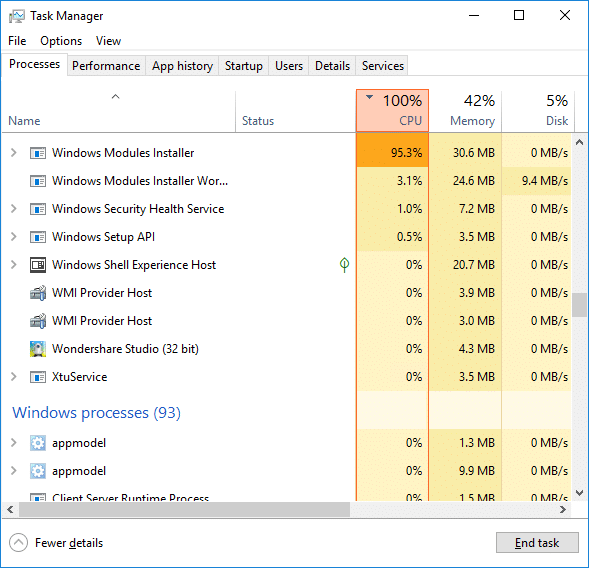
If you are facing the High CPU Usage by Windows Modules Installer Worker, then don’t worry as thousands of other users are also facing the similar problem and therefore, there are many working fixes which we will be discussing today in this article. To verify if you are facing this issue open Task Manager (Ctrl + Shift + Esc) and you will find that the Windows Modules Installer Worker is consuming High CPU or Disk Usage.

प्रो सुझाव: You may leave your PC overnight or for a few hours to see the issue rectify itself once the Windows is finished downloading and installing updates.
What is Windows Modules Installer worker (WMIW)?
Windows Modules Installer worker (WMIW) is a service which takes cares of automatically installing Windows Update. According to its service description, WMIW is a system process that enables automatic installation, modification, and removal of Windows updates and optional components.
This process is responsible for finding new Windows Update automatically and installing them. As you might be aware that Windows 10 automatically install newer builds (i.e. 1803 etc.) via Windows Updates, so this process is responsible for installing these updates in the background.
Although this process is called Windows Modules Installer worker (WMIW) and you will see the same name in the Processes tab in the Task Manager, but if you switch to Details tab, then you will find the name of the file as TiWorker.exe.
Why Is Windows Modules Installer worker Using So Much CPU?
As Windows Modules Installer worker (TiWorker.exe) runs continuously in the background, sometimes it might utilize high CPU or disk usage when installing or uninstalling Windows Updates. But if its constantly using high CPU then the Windows Modules Installer worker may have become unresponsive while checking new updates. As a result, you may be experiencing lags, or your system might hang or freeze completely.
The first thing users do when they experience freezing, or lagging issues on their system is to restart their PC, but I assure you that this strategy won’t work in this case. This is because the issue will not resolve by itself until and unless you fix the underlying cause.
Fix Windows Modules Installer Worker High CPU Usage
केहि गलत भएको अवस्थामा पुनर्स्थापना बिन्दु सिर्जना गर्न निश्चित गर्नुहोस्।
Windows Modules Installer Worker (WMIW) is an important service, and it should not be disabled. WMIW or TiWorker.exe is not a virus or malware, and you cannot just delete this service from your PC. So without wasting any time let’s see How to Fix Windows Modules Installer Worker High CPU Usage तल सूचीबद्ध समस्या निवारण गाइडको मद्दतले।
विधि 1: विन्डोज अपडेट ट्रबलशुटर चलाउनुहोस्
1. खोल्न Windows Key + I थिच्नुहोस् सेटिङ त्यसपछि क्लिक गर्नुहोस् अपडेट र सुरक्षा आइकन।
![]()
2. बायाँ हातको मेनुबाट, चयन गर्नुहोस् समस्या निवारण अन्तर्गतउठ्नुहोस् र दौडिँदै" थिच्नुस विन्डोज अपडेट।

Now. अब क्लिक गर्नुहोस् "समस्या निवारण चलाउनुहोस्” under Windows Update.
4. Let the troubleshooter run, and it will automatically fix any issues found with Windows Update taking forever.
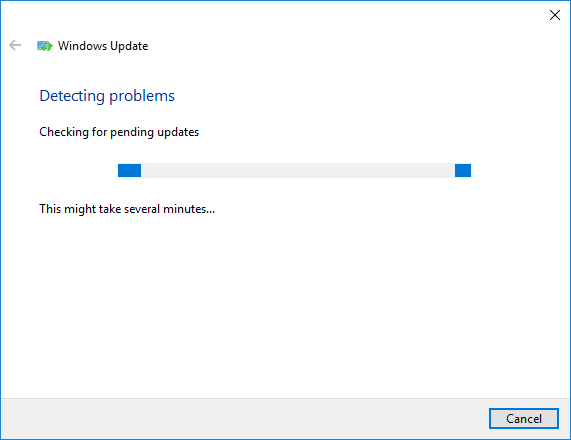
Method 2: Manually Check for Windows Updates
1. Windows Key + I थिच्नुहोस् त्यसपछि चयन गर्नुहोस् अपडेट र सुरक्षा।
2. बायाँ तर्फबाट, मेनुमा क्लिक हुन्छ विन्डोज अपडेट।
3. अब क्लिक गर्नुहोस् "अद्यावधिकहरूको लागि जाँच गर्नुहोस्कुनै पनि उपलब्ध अद्यावधिकहरू जाँच गर्न बटन।

4. कुनै पनि अद्यावधिक पेन्डिङ छ भने, त्यसपछि क्लिक गर्नुहोस् अपडेटहरू डाउनलोड र स्थापना गर्नुहोस्।

5. अपडेटहरू डाउनलोड भएपछि, तिनीहरूलाई स्थापना गर्नुहोस्, र तपाईंको विन्डोज अप-टु-डेट हुनेछ।
Method 3: Configure Windows Update to Manual
सावधानी: This method will switch Windows Update from automatically installing the new updates to the manual. This means you have to manually check for Windows Update (weekly or monthly) to keep your PC secure. But follow this method, and you can again set the Updates to Automatic once the issue is resolved.
1. Windows Key + R थिच्नुहोस् त्यसपछि टाइप गर्नुहोस् services.msc र दर्ता गर्नुहोस्।

2. Scroll down and find विन्डोज मोड्युल स्थापनाकर्ता service in the list.
२ मा दायाँ क्लिक गर्नुहोस् विन्डोज मोड्युल स्थापनाकर्ता सेवा र चयन गर्नुहोस् गुणहरू।
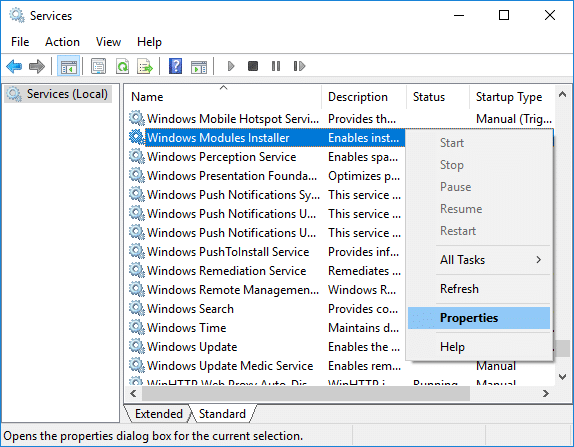
Now. अब क्लिक गर्नुहोस् रोक्नुहोस् then from the स्टार्टअप प्रकार drop-down select म्यानुअल।
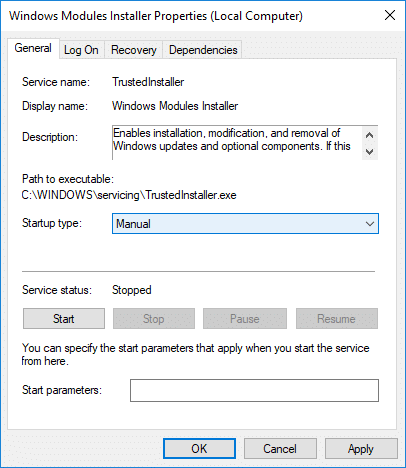
5. लागू गर्नुहोस् क्लिक गर्नुहोस्, त्यसपछि ठिक छ।
6. Similarly, follow the same step for the Windows Update service.

7. परिवर्तनहरू बचत गर्न आफ्नो पीसी रिबुट गर्नुहोस्।
२. फेरि लागि जाँच गर्नुहोस् Windows Updates Manually र कुनै पनि पेन्डिङ अद्यावधिकहरू स्थापना गर्नुहोस्।
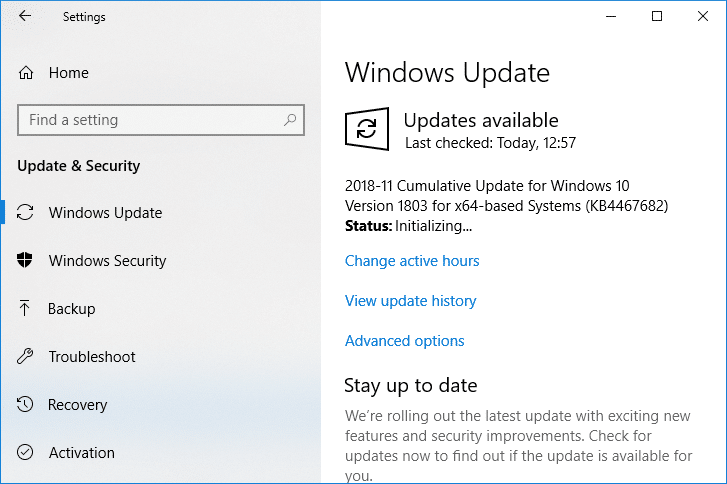
9. Once is done, again go back to services.msc window and open the Windows Modules Installer & Windows Update Properties सञ्झ्याल।
Set. सेट गर्नुहोस् स्टार्टअप प्रकार लाई स्वचालित र क्लिक गर्नुहोस् सुरु. Then click Apply followed by OK.
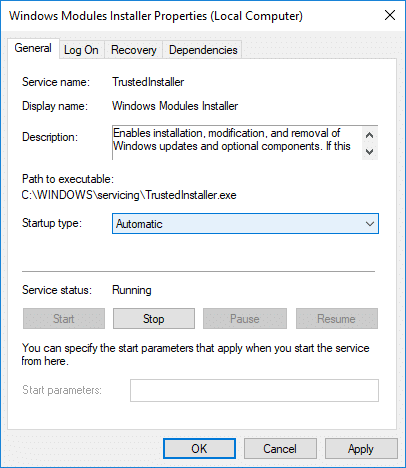
11. परिवर्तनहरू बचत गर्न आफ्नो पीसी रिबुट गर्नुहोस्।
विधि 4: प्रणाली मर्मत समस्या निवारक चलाउनुहोस्
1. Windows Key + R थिच्नुहोस् त्यसपछि control टाइप गर्नुहोस् र खोल्न इन्टर थिच्नुहोस् नियन्त्रण प्यानल।

2. खोज समस्या निवारण र क्लिक गर्नुहोस् समस्या निवारण।

२. अब क्लिक गर्नुहोस् सबै हेर्नुहोस् बायाँ फलकमा।
4। थिच्नुस “System Maintenance” चलाउन System Maintenance Troubleshooter.

5. समस्या निवारक सक्षम हुन सक्छ Fix Windows Modules Installer Worker High CPU Usage, but if it didn’t, then you need to run System Performance Troubleshooter.
6. कमाण्ड प्रम्प्ट खोल्नुहोस्। प्रयोगकर्ताले खोजी गरेर यो चरण प्रदर्शन गर्न सक्छ 'सेमीडी' र त्यसपछि Enter थिच्नुहोस्।

7. cmd मा निम्न आदेश टाइप गर्नुहोस् र इन्टर थिच्नुहोस्:
msdt.exe / आईडी प्रदर्शन Diagnostic
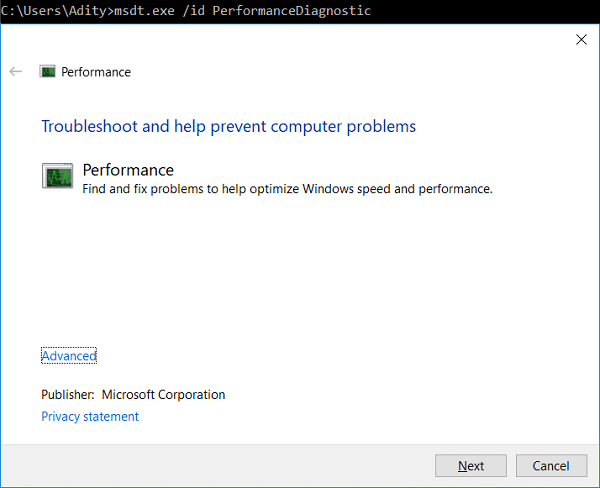
8. Follow the on-screen instruction to run the troubleshooter and fix any issues find the System.
9. Finally, exit the cmd and reboot your PC.
Method 5: Disable Automatic Maintenance
Sometimes Automatic Maintenance can conflict with the Windows Modules Installer Worker service, so try to disable Automatic Maintenance using this guide and see if this fixes your issue.
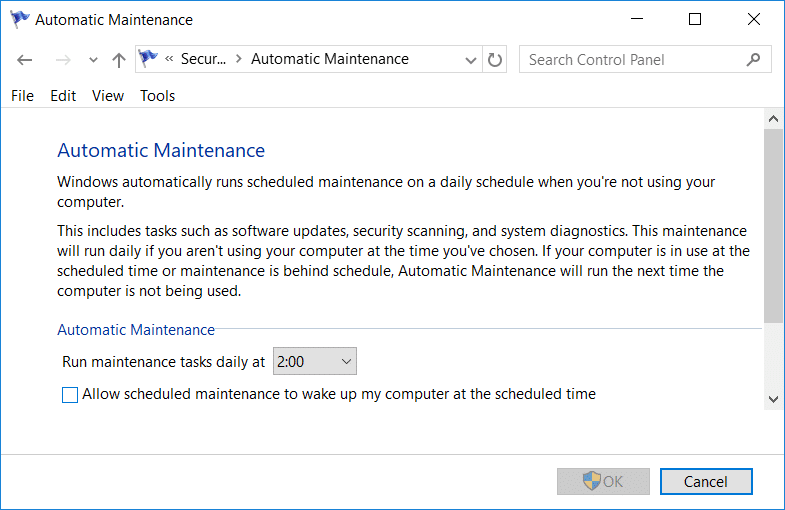
Although disabling Automatic Maintenance is not a good idea, but there might be some case where you need to actually disable it, for example, if your PC freezes during automatic maintenance or Windows Modules Installer Worker High CPU Usage issue then you should disable maintenance to troubleshoot the issue.
Method 6: Run System File Checker and DISM
1. कमाण्ड प्रम्प्ट खोल्नुहोस्। प्रयोगकर्ताले खोजी गरेर यो चरण प्रदर्शन गर्न सक्छ 'सेमीडी' र त्यसपछि Enter थिच्नुहोस्।
2. अब cmd मा निम्न टाइप गर्नुहोस् र इन्टर थिच्नुहोस्:
Sfc /scannow sfc /scannow /offbootdir=c: /offwindir=c:windows (यदि माथि असफल भएमा यो प्रयास गर्नुहोस्)

3. माथिको प्रक्रिया समाप्त हुनको लागि पर्खनुहोस् र एक पटक सकिएपछि, तपाइँको पीसी पुन: सुरु गर्नुहोस्।
4. फेरि cmd खोल्नुहोस् र निम्न आदेश टाइप गर्नुहोस् र प्रत्येक पछि इन्टर थिच्नुहोस्:
Dism/Online/Cleanup-Image/CheckHealth Dism/Online/Cleanup-Image/ScanHealth Dism/Online/Cleanup-Image/RestoreHealth

5. DISM आदेश चल्न दिनुहोस् र यसलाई समाप्त हुनको लागि पर्खनुहोस्।
6. यदि माथिको आदेशले काम गर्दैन भने, त्यसपछि तलको प्रयास गर्नुहोस्:
Dism/Image:C:offline/Cleanup-Image/RestoreHealth/Source:c:testmountwindows Dism/Online/Cleanup-Image/RestoreHealth/Source:c:testmountwindows/LimitAccess
नोट: C:RepairSourceWindows लाई आफ्नो मर्मत स्रोत (Windows Installation वा Recovery Disc) सँग बदल्नुहोस्।
7. परिवर्तनहरू बचत गर्न आफ्नो पीसी रिबुट गर्नुहोस् र हेर्नुहोस् यदि तपाईं सक्षम हुनुहुन्छ Fix Windows Modules Installer Worker High CPU Usage.
विधि 7: सफा बुट प्रदर्शन गर्नुहोस्
Sometimes 3rd party software can conflict with Windows and can cause the issue. To Fix Windows Modules Installer Worker High CPU Usage issue, तपाईंले आफ्नो PC मा सफा बुट प्रदर्शन गर्न आवश्यक छ र चरण द्वारा मुद्दा निदान।
Method 8: Set your WiFi as Metered Connection
नोट: This will stop Windows Automatic Update, and you will need to manually check for Updates.
1. खोल्न Windows Key + I थिच्नुहोस् सेटिङ त्यसपछि क्लिक गर्नुहोस् नेटवर्क र ईन्टरनेट।

2. बायाँ हातको मेनुबाट, चयन गर्नुहोस् वाइफाइ
3. Under Wi-Fi, क्लिक on your currently connected network (WiFi).
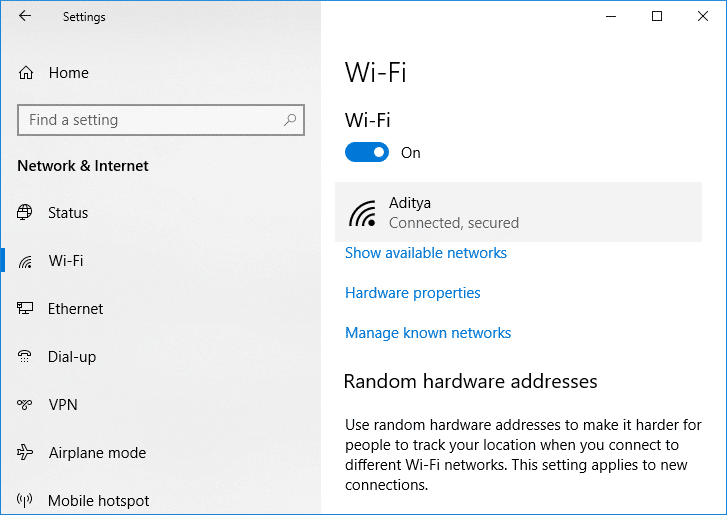
4. Scroll down to Metered connection and टगल सक्षम गर्नुहोस् अन्तर्गतमेटिएको जडानको रूपमा सेट गर्नुहोस्"।
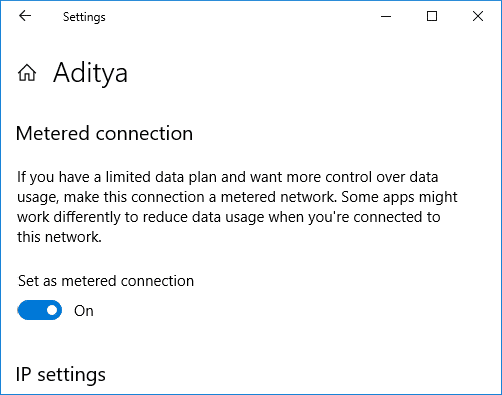
5. Close Settings and reboot your PC to save changes.
सिफारिस गरिएको:
त्यो हो, तपाईले सफलतापूर्वक गर्नुभयो Fix Windows Modules Installer Worker High CPU Usage तर यदि तपाईंसँग अझै पनि यस ट्यूटोरियलको बारेमा कुनै प्रश्नहरू छन् भने टिप्पणीको खण्डमा तिनीहरूलाई सोध्न नहिचकिचाउनुहोस्।
